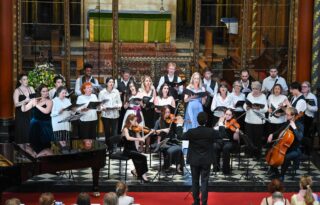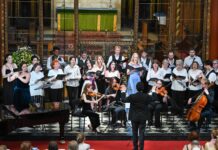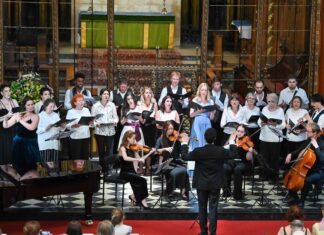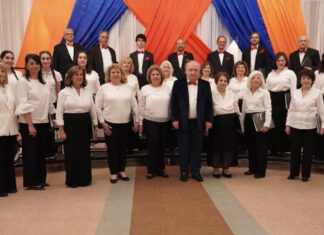The architecture of Rostom Voskanian can be described as a sober, real and deeply persuasive answer to the wide-ranging dilemmas of modernism between the 1960s and the 1990s. Primarily working in a rapidly-developing Iran, Voskanian’s architecture was born out of a Beaux-Art tradition that helped transform and define Iranian as well as diasporan Armenian modernism.
Voskanian was born into a Christian Armenian family from Tabriz. He was picked as the fifth recipient of the prestigious Paris scholarship for architects who were sponsored by the state to study in France. Graduating from the l’Ecole des Beaux-Arts in 1964, he returned to Tehran University as an assistant professor, initially working with renowned Iranian architect and educator, Houshang Seyhoun. Voskanian soon became the dean of Tehran University’s School of Architecture after Seyhoun and chaired it until the temporary closing of the university in 1980. In an interview some 10 years ago, Voskanian noted, “Those who returned from Europe had considerable influence.”
Seyhoun, himself one of the earliest Beaux-Art architects in Iran, was critical of the “design of Armenian architects,” namely leading first-generation architects Vartan Hovanessian and Gabriel Guevrekian, because, as Voskanian noted, “they were after modernism.”
In the mid-1960s, trends were changing swiftly in Iran and Voskanian was initially a witness to and soon an instigator of these stylistic transformations. By the early 1970s, “the university saw the birth of Regionalism, cultural sensitivity,” maintained Voskanian, adding, “Finally, we gave up Formalism.” The discourse on Iranian architecture had shifted from the International Style of the 1930s and the Beaux-Arts principles of the 1950s to the reinvention of a new modern and local architecture of and for Iran.
In 1973, Voskanian made a special visit to the office of the renowned architect, Louis Kahn, and examined his large-scale works that paid particular attention to details. Kahn’s monumental regionalism had a particular influence on Voskanian’s subsequent architecture. Kahn was proposing to the world a new modernism that was regional and modernistic; a tradition that Voskanian carried forward faithfully in Iran. At the time, Voskanian could not have known that the last two decades of his creative life would be spent not too far from Kahn’s masterpiece: the Salk Institute for Biological Studies in La Jolla, Calif.
In 1974, Voskanian became the head of the architectural department for the following three years, when the revolutionary movement forced him to resign his post. Championed and often sponsored by Empress Farah Pahlavi, notable examples of this new regionalism included praiseworthy examples in Tehran: Kamran Diba’s Tehran Museum of Contemporary Art (1976); Amanat’s Shahyad Aryamehr Monument-Museum (1971-74); Nader Ardalan’s Iran Centre for Management Studies (1974) and Voskanian’s Holy Cross Chapel on the grounds of Ararat Sport Complex (1987). These outstanding works of architecture represent the originality, productivity, and stylistic richness that existed in modern Iran.
Of the Masterpiece
Voskanian undertook his largest commission in 1971 for the Ararat Armenian Cultural Organization: a 10,000-seat athletic stadium in northern Tehran. The two-hectares-plus land had historically belonged to the Armenian community as a Christian cemetery from the 17th century. A six-member committee was formed to manage the establishment of this massive project. A design competition was organized, wherein Voskanian won first prize. He had been a longtime member of the Ararat organization and a veteran sportsman and mountaineer. That he was one of the leading architects of Iran sealed the selection. But there was something else at play here; Voskanian was above all a man of integrity, a people’s architect.
Unlike postmodernists, modern architects believed in changing the world for the better for everyone. The welfare of ordinary people was always at stake, always at the forefront of priority. For Voskanian this was of essence. And like Voskanian, this priority has come and gone.
That Voskanian won the bid was indicative of the populist spirit of the project. Chairman of central broad of directors and head of constructions of Ararat, Vachik Gharabegian, was pivotal to inseminating among the Armenian community of Iran, the idea of ownership. Of owning one’s land, one’s culture and thus one’s destiny. An essential aspect of that will to ownership was the realization of the Ararat project. Donations were collected from the community. The architect and his team were supported by the board of directors in this politically and financially sensitive undertaking. At the end, Voskanian’s design successfully rose to the expectations of the will of the people, of openness, transparency and communal ownership.
A topographically difficult terrain with a difference in elevation of 26 meters, did not phase Voskanian, who instead managed to turn it into a series of highly functional and spatially effective agglomeration arranged around the soccer field and each maintaining their individuality and independence. The modernist design of the structures went hand in hand with the choice of the material and function: pure concrete, brick, and glass. The people’s stuff. The complex was ready for partial use as of 1975; the project was handed over to the Executive Board of Ararat in late 1976.
The project’s implication for the Armenian community not only in Tehran, but also all around Iran and Asia, has been vast since the inception of the project. This space has become a sanctuary for Christian Armenians in order to survive as an independent cultural, ethnic, religious, and linguistic minority in the Islamic Republic of Iran. The Ararat Sport Complex has provided Armenians the space in which to practice their cultural and linguistic heritage and to preserve its ethnic and religious distinctiveness. The masterful architecture of the varied spaces of the complex has been since its construction the key to this preservation: a large open-air stadium, several indoor and outdoor sports halls, tennis courts, offices, classrooms, meeting halls, storage rooms, shops, camping areas, parking amenities, and a world-class swimming facility. In the following years, the stadium was used for significant community and national events as a result of its successful spatial configuration, solid construction, and forward-looking engineering.
Voskanian’s Holy Cross Chapel on the southeastern corner of the campus was an addition after the Iranian Revolution of 1979, which certainly encapsulates not only the architect’s artistic and architectural brilliance, but also his lifelong commitment to both the people and to a local modernism: the modern Armenian religious structure. The Iranian Revolution that took an Islamic turn in 1980-82, gave urgency to the construction of an explicitly Christian icon in the existing stadium complex. Iranian identity framed by the authorities in terms of religion compelled minorities, including Armenians, to represent themselves as religious minorities. Although initially the complex was designed and used as a secular space, Ararat’s governing committee judged it best in the early 1980s to erect an Armenian Apostolic chapel in order to continue to preserve the complex as a property belong to the Armenian community.
As many properties were being seized during the chaos of the revolution, the governing committee petitioned for an urgent approval of the design of the proposed chapel by the Armenian Apostolic Prelacy of Iran. Voskanian’s scheme was a masterpiece of modern Armenian architecture: a reinterpretation in poured concrete of the best examples of medieval Armenian churches, transformed into an interwoven system of supports, openings, and suspensions. While remaining true to the symmetric and central floor plan of domed architecture of medieval Armenian churches, for instance that of Saint Hripsimeh in Ejmiatsin or the Holy Cross (Surb Khatch) on the island of Akhtamar, Voskanian carves out a novel form that boldly incarnates the elevation and section of traditional churches into an allegorical representation of the Christian cross: simultaneously ancient and avant-garde. An architecture of sculpture or a sculpted architecture, the chapel stands as the most powerful symbol of the endurance of Armenian identity as both ancient and contemporary.
Voskanian’s avant-garde architecture was highly progressive and revolutionary, then and now. Finding the proposal, as it were, “too modern and unorthodox,” the Armenian prelate ordered the imitation of a church in Antioch, Syria, dating from the 19th century.
“Your holiness, I am either building this or nothing at all,” Voskanian replied.
A man of integrity, of principles. A modern man of the people; a true modernist architect. To this, the stadium’s chairman, Baghdik Der Grigorian had added, “Clearly sir, you don’t grasp the real implication of this monument, skirmishing over its style.”
The architect tirelessly supervised the complex and unique construction process of the matur (chapel, in Armenian) during the following months. In September 1987, the matur was consecrated.
“I never approached the chapel as a political work,” Voskanian told me decades later. “That which has been built, is a reality that remains; people change their political views, which have no influence on my art.” The matur has helped maintain the stadium as an essential aspect of the preservation of Armenian cultural heritage in Iran.
Of the Legacy
As most revolutions do, the Iranian Revolution has taken away from artists and architects their livelihood and peace of mind, as well as their guarantee of posterity. Voskanian left behind a legacy and a tradition in Iranian-Armenian modern architecture when he left Tehran in 1988. By so doing, he also left behind his architectural practice. Moving to Southern California, he showed an exceptional ability to adapt. With his Beaux-Arts training, Voskanian dropped the ruler and picked up the brush, perhaps because to a Beaux-Arts-trained architect, painting and sculpting are sub-processes of the artistic process. He restlessly produced works of art in his home-studio in Glendale. This resulted, over the last two decades, in a series of very successful one-person and group exhibitions in various North American cities.
Yet at his core, Voskanian remained a modernist architect. His matur embodies one of the few examples of Armenian contemporaneity in architecture; an exquisite answer to the history of architecture’s modernism, to Corbu, Mies, Gropius, and Kahn. The matur is a masterpiece. With the skillful pouring of concrete, with its protruding three-dimensional crosses, with its low modernist interior reliefs, and with its quadrupling of design, it is an answer to “how does modern Armenian architecture look?” An answer to the Modern Movement, of which Voskanian was a faithful follower. Simultaneously, his works belong to the rich repertoire of Armenian architectural tradition. His legacy is the persistence of the modern and the traditional in Armenian art history. Therein rests his work’s genius. The matur, as all his other architectural and fine-arts creations, stands tall as a brilliant manifesto of his intellectual powers, his profound philosophy, his artistic talent and his unique instinct and insight.
That both King Gagik’s cathedral on the Akhtamar island and Voskanian’s chapel on the grounds of Ararat stadium are named Holy Cross is prophetic. Both stand proud as representative masterworks of Armenian architecture, one of the Middle Ages and the other of the modern era. Gagik’s exquisite high reliefs on the surface of Holy Cross are echoed by the equally exquisite minimalism of the poured concrete of Voskanian’s Holy Cross. One could touch both surfaces and grasp the artistic spirit of its time. Both speak so sincerely of their Zeitgeist (spirit of the age), of their place, of their artistic foresight. Visionary and deeply true.
To have lost one’s context in which one had made his name, yet to persistently continue to create original, thought-provoking, and critical work of art is a mark of an exceptional mind, a pure heart, and a true artist. Voskanian was that architect-artist. To have lost that artist to cancer is the loss of not one but two nations, if not the entire artistic world. Not one, but two nations are at a loss today. Not one but two nations ought to mourn today. One of unmatched talent, one of integrity and honor, one who believed in the project of modernity and with his creation, became one with it. May he rest in peace as his art endures onto eternity.
(Talinn Grigor is a professor of art history at Brandeis University.)








